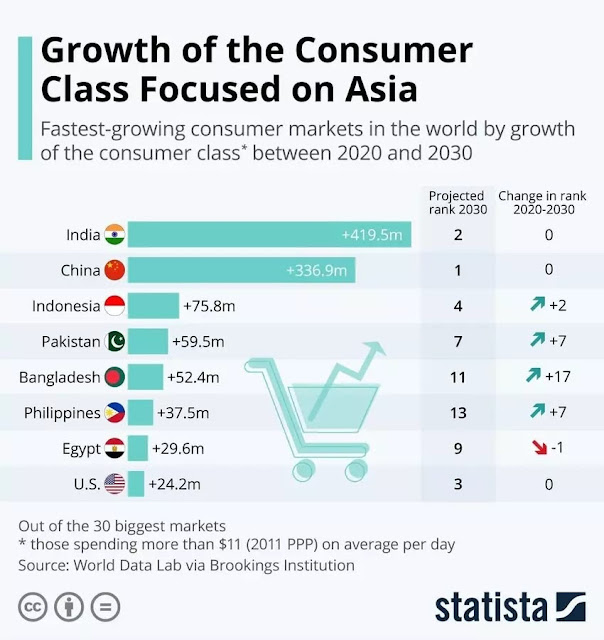Nearly 700,000 Pakistani Workers Have Gone Overseas so far in Year 2022
By Riaz Haq
CA

Nearly 700,000 Pakistanis have left to work overseas in the first 10 months of the current calendar year, according to Pakistan's Bureau of Emigration Overseas Employment ( BEOE ). The worker migration from Pakistan had dipped to 225,000 in 2020 and 280,000 in 2021 due to Covid restrictions around the world.
The yearly average for the last decade was over half a million Pakistanis migrating to other countries for work. The data from International Organization for Migration ( IOM ) shows that a lot more of the Pakistan migrants are now skilled labor while the share of unskilled migrants is declining: "Pakistani migrant workers were skilled (42%) and involved in semi-skilled jobs such as welders, secretaries, masons, carpenters, plumbers and so on. Another proportion of the labor migration was composed of unskilled laborers (39%) such as agriculturists, laborers or farmers. Projections about future trends indicate that the number of Pakistani labor migrants will continue rising to reach 15.5 million in 2020 (Government of Pakistan, 2018". Larger and increasingly higher skilled diaspora is expected to sustain double-digit annual growth in overseas worker remittances to Pakistan.

Pakistani workers going overseas - Bureau of Emigration
Demographic Dividend
With rapidly aging populations and declining number of working age people in North America, Europe, and East Asia, the demand for workers will increasingly be met by major labor exporting nations like Bangladesh, China, India, Mexico, Pakistan, Russia and Vietnam. Among these nations, Pakistan is the only major labor exporting country where the working age population is still rising faster than the birth rate.
Over 10 million Pakistanis are currently working/living overseas, according to the Bureau of Emigration. Before the COVID19 pandemic hit in 2020, more than 600,000 Pakistanis left the country to work overseas in 2019. Nearly 700,000 Pakistanis have already migrated in this calendar year as of October 2022. The average yearly outflow of Pakistani workers to OECD countries (mainly UK and US) and the Middle East was over half a million in the last decade.

Consumer markets in 2030 - WEF
World's 7th Largest Consumer Market
Pakistan's share of the working age population (15-64 years) is growing as the country's birth rate declines, a phenomenon called demographic dividend . With its rising population of this working age group, Pakistan is projected by the World Economic Forum to become the world's 7th largest consumer market by 2030. Nearly 60 million Pakistanis will join the consumer class (consumers spending more than $11 per day) to raise the country's consumer market rank from 15th to 7th by 2030. WEF forecasts the world's top 10 consumer markets of 2030 to be as follows: China, India, the United States, Indonesia, Russia, Brazil, Pakistan, Japan, Egypt and Mexico. Global investors chasing bigger returns will almost certainly shift more of their attention and money to the biggest movers among the top 10 consumer markets, including Pakistan. Already, the year 2021 has been a banner year for investments in Pakistani technology startups .
Record Remittances by Overseas Pakistanis
Pakistan is already witnessing high levels of labor export and record remittances of over $30 billion pouring into the country. Saudi Arabia and the United Arab Emirates (UAE) are the top two sources of remittances but the biggest increase (58%) in remittances is seen this year from Pakistanis in the next two sources: the United Kingdom and the United States.
Remittances from the European Union (EU) to Pakistan soared 49.7% in FY 21 and 28.3% in FY22, according to the State Bank of Pakistan. With $2.5 billion remittances in the first 9 months (July-March) of the current fiscal year, the EU ($2.5 billion) has now surpassed North America ($2.2 billion) to become the third largest source of inflows to Pakistan after the Middle East and the United Kingdom. Remittances from the US have grown 21%, second fastest after the EU (28.3%) in the first 9 months of the current fiscal year.
Pakistan ranks 6th among the top worker remittance recipient countries in the world. India and China rank first and second, followed by Mexico 3rd, the Philippines 4th, Egypt 5th and Pakistan 6th.
About two million Pakistanis are entering the workforce every year. The share of the working age population in Pakistan is increasing while the birth rate is declining. This phenomenon, known as demographic dividend , is coinciding with declines in working age populations in developed countries. It is creating an opportunity for over half a million Pakistani workers to migrate and work overseas, and send home record remittances.
(Riaz Haq is a Silicon Valley-based Pakistani-American analyst and writer. He blogs at www.riazhaq.com )

